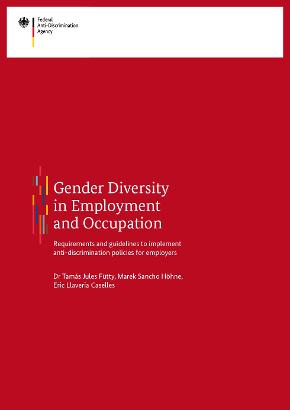Gender Diversity in Employment and Occupation
Requirements and guidelines to implement anti-discrimination policies for employers
- Fact sheet on the research project -
Authors: Dr. Tamás Jules Fütty, Marek Sancho Höhne, Eric Llaveria Caselles, published by the Federal Anti-Discrimination Agency (FADA) Year of publication: 2020
Brief overview
The study looks at the question of how, after the introduction in 2018 of the positive civil status “diverse” (section 22 (3) Civil Status Act PStG), companies can design work places and organise work in such a way that discriminations on grounds of gender diversity are avoided in all phases of employment and occupation. In its introduction, the study cites current national and international research to highlight the persistent structural discriminations against gender-diverse persons in the world of work. Based on the analysis of the current research and interviews with experts, it goes on to identify fields of action for anti -discrimination of gender-diverse persons in employment and occupation. Building on these, the study develops approaches to achieving the inclusion of gender-diverse persons in the workplace. The key aim is to make employers and functionaries aware of the recognition of gender-diversity and offer concrete guidance for implementing the inclusion of gender-diverse staff. The needs and recommendations mainly refer to the following six fields of action: corporate culture, recruitment, handling gender-related data, language and communication, sanitary and changing facilities as well as body, clothing and health.
Main results
The current national and international state of research on the discrimination of inter*, trans* and non-binary-persons illustrates that structural discriminations still pervade all areas of society and adversely affect the life situation and health of gender-diverse persons.
In employment and occupation, too, disadvantages as a result of binary norms occur in all phases and aspects of gender-diverse persons’ working life. However, the current legal framework conditions underscore that employers are already now required to implement anti -discrimination policies for the benefit of gender-diverse staff.
Options for action
The discrimination risks and experiences described suggest where discriminations against gender-diverse persons in employment and occupation must be reduced and prevented. Action is needed in six central areas:
All-gender-inclusive corporate culture
A must is the structural establishment of an all-gender-inclusive corporate culture, based on awareness-raising measures targeted at management, human resource managers and employees. The goal here is to promote a basic understanding of why real changes, for instance regarding personnel policy, language or toilets, must be made. This subsection also discusses how to handle resistance in the workforce to transformation processes and discrimination incidents. A preventive approach and educational measures are particularly important in this regard. In addition, this subsection discusses public relations work and networks that promote the recognition of gender diversity and the implementation of an all gender inclusive company culture in internal and external communication.
Recruitment
In terms of recruitment, it starts with gender-diverse recruitment practices, language and the handling of application documents and preferred names that differ from those contained in certificates and transcripts. It then provides recommendations for recruitment procedures in order to ensure equal treatment of gender-diverse employees, such as transparent selection criteria and professional and all gender inclusive interactions with candidates during interviews. In addition, a separate module addresses the specific features of gender-specific job advertisements.
Handling of gender-related data
The practical handling of gender-related data implements measures supporting gender diversity and to comply with informational self-determination and data protection requirements. The study recommends that the collection and use of gender-related data should be restricted to what is legally required, without reinforcing any existing discrimination in the process. To this end, we specifically address the handling of official data (first name and legal gender marker) in human resource management. Moreover, various options for implementing changes in the name and legal gender marker of gender-diverse employees are examined in detail. Furthermore, we discuss the technical feasibility of work organisation tools, such as recommendations for employment contracts and employers’ references.
Gender inclusive language and communication
Also important are gender inclusive language and communication in relation to inter*, trans* and (other) non-binary people and how it can be implemented. The key here is the use of self-designations, names and pronouns and the correct way of addressing gender-diverse employees in day-to-day working life. In addition to resources and specific language examples, we outline the basic principles of inclusive language and communication. Moreover, recommendations are given on how to transition to all gender inclusive language and communicate new names or forms of address for employees.
Sanitary facilities
Particular sensitivity is required when making sanitary facilities at work inclusive for gender diverse persons. The study raises awareness about the need to make sanitary facilities at the workplace gender inclusive. In this context, people often overlook the fact that gender-neutral toilets and changing rooms have long been the norm in everyday life in places such as trains, planes or shops that only have single cubicles. The study explores the potential resistance of staff and provides specific recommendations for the design and labelling of gender-neutral sanitary facilities at the workplace.
Gender-diverse work clothing
It addresses both formal regulations for gender-diverse work clothing and questions relating to informal rules for “acceptable” appearance and conduct. Since the latter are opaque and intricately linked to binary norms, they pose a particular risk of discrimination for gender-diverse employees. In addition to specific guidance on all gender inclusive dress codes, considerations and understanding of gendered informal regulations on “professional appearance and conduct” are the central discussion in this sub-section. Furthermore, occupational health and safety for gender-diverse employees is discussed in greater detail. This includes the handling of gender-related medical procedures, assumed frequent periods of absence due to illness and increased psychological stress. Important information is also provided on considerations of gender diversity in health management (including considerations for pregnancy and parental leave regulations) and for preventing retraumatisation and preserving physical integrity during medical examinations.
The final service section covers assistance and detailed information and provides references to additional resources, including guides, guidelines and manuals, some of which contain links.

